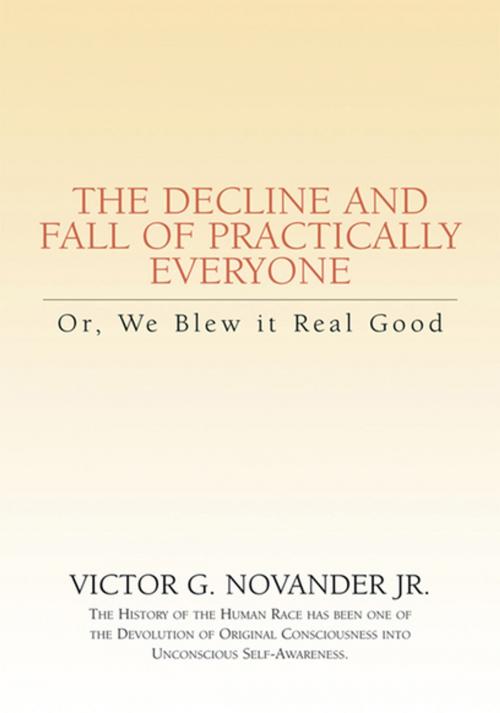| Author: | Victor G. Novander Jr. | ISBN: | 9781462806669 |
| Publisher: | Xlibris US | Publication: | March 7, 2006 |
| Imprint: | Xlibris US | Language: | English |
| Author: | Victor G. Novander Jr. |
| ISBN: | 9781462806669 |
| Publisher: | Xlibris US |
| Publication: | March 7, 2006 |
| Imprint: | Xlibris US |
| Language: | English |
The Decline and Fall of Practically Everyone is a concise history of humanity. It is written from the point of view of someone whose outlook on life has been transformed by primal therapy and who has become a lifelong primal person. No other history has been written from this unique perspective. The Decline and Fall of Practically Everyone offers to each one who is ready for it a fresh glimpse into his own history and into a sound understanding of the course all human history has taken toward the devolution of original human consciousness into unconscious self-awareness. In Part I, the author defines consciousness, unconscious self-awareness, primal pain, primaling and what living a primal life involves. He pictures the primal life as putting ones feet on the path toward greater consciousness. The authors stated purpose is to wake us up to our condition of unconscious self-awareness. He feels that, unless we are awakened, humanity will continue to careen toward destroying itself and the life-sustaining nurture of Earth. The authors approach to the necessary awakening is historical. If one can see history through primal eyes, one will not only see the devolution of consciousness into unconscious self-awareness down through the millennia, one will sense it in ones own life and do something about it. Then in Part II, he explores various attributes of unconscious self-awareness that are relevant to a primal understanding of history. These subjects include the basic split, the point at which unconscious self-awareness completely suppresses consciousness; the location and upward movement of unconscious self-awareness in the body; the experience of time and space; the changing nature of the supreme deity and the four motifs of religion. In Part III, the author begins to explore the historical devolution of original consciousness into unconscious self-awareness. Subjects revealing the devolution include beliefs regarding the origin of the cosmos and of humanity; the destiny of the dead; shamanism; the several millennia-long invasions by Warrior God societies of Mother Goddess cultures and the revolutionary religions of Buddhism and Christianity. In the authors view, everything that has happened since the 1st millennium B.C.E. is but a footnote to it, and he therefore skips to the Americas in the 15th century. In Part IV, the author concentrates on greed and lust for power as the chief characteristics of unconscious self-awareness in the modern period. He begins with Columbus and the euphemistically named Age of Exploration to illustrate how greed and the lust for power dominated the Western European Colonial powers. Next, he shows how the Age of Enlightenment and its major philosophers and economists provided the basis for our Founding Fathers to craft a constitution that enshrined themselves as a rich and powerful, elite ruling class. To illustrate the greed and lust for power of unconscious self-awareness in the rest of U.S. history, he discusses economics, individualism, class and class struggle, differences among people and between men and women in the degree of unconscious self-awareness, family parenting models, unilateralism as the national expression of individualism and the U.S. as a nation dominated by greed, by a lust for power, by a quest for world domination and by the willingness to use violence and terror to achieve these ends. In the final chapter, the author reiterates his purpose of awakening his readers from the state of unconscious self-awareness. In contrast to a strictly psychological approach to fulfill his purpose, the author has adopted, in addition, a perspective that encompasses the whole sweep of human history. He ends by offering a cautious optimism for the future.
The Decline and Fall of Practically Everyone is a concise history of humanity. It is written from the point of view of someone whose outlook on life has been transformed by primal therapy and who has become a lifelong primal person. No other history has been written from this unique perspective. The Decline and Fall of Practically Everyone offers to each one who is ready for it a fresh glimpse into his own history and into a sound understanding of the course all human history has taken toward the devolution of original human consciousness into unconscious self-awareness. In Part I, the author defines consciousness, unconscious self-awareness, primal pain, primaling and what living a primal life involves. He pictures the primal life as putting ones feet on the path toward greater consciousness. The authors stated purpose is to wake us up to our condition of unconscious self-awareness. He feels that, unless we are awakened, humanity will continue to careen toward destroying itself and the life-sustaining nurture of Earth. The authors approach to the necessary awakening is historical. If one can see history through primal eyes, one will not only see the devolution of consciousness into unconscious self-awareness down through the millennia, one will sense it in ones own life and do something about it. Then in Part II, he explores various attributes of unconscious self-awareness that are relevant to a primal understanding of history. These subjects include the basic split, the point at which unconscious self-awareness completely suppresses consciousness; the location and upward movement of unconscious self-awareness in the body; the experience of time and space; the changing nature of the supreme deity and the four motifs of religion. In Part III, the author begins to explore the historical devolution of original consciousness into unconscious self-awareness. Subjects revealing the devolution include beliefs regarding the origin of the cosmos and of humanity; the destiny of the dead; shamanism; the several millennia-long invasions by Warrior God societies of Mother Goddess cultures and the revolutionary religions of Buddhism and Christianity. In the authors view, everything that has happened since the 1st millennium B.C.E. is but a footnote to it, and he therefore skips to the Americas in the 15th century. In Part IV, the author concentrates on greed and lust for power as the chief characteristics of unconscious self-awareness in the modern period. He begins with Columbus and the euphemistically named Age of Exploration to illustrate how greed and the lust for power dominated the Western European Colonial powers. Next, he shows how the Age of Enlightenment and its major philosophers and economists provided the basis for our Founding Fathers to craft a constitution that enshrined themselves as a rich and powerful, elite ruling class. To illustrate the greed and lust for power of unconscious self-awareness in the rest of U.S. history, he discusses economics, individualism, class and class struggle, differences among people and between men and women in the degree of unconscious self-awareness, family parenting models, unilateralism as the national expression of individualism and the U.S. as a nation dominated by greed, by a lust for power, by a quest for world domination and by the willingness to use violence and terror to achieve these ends. In the final chapter, the author reiterates his purpose of awakening his readers from the state of unconscious self-awareness. In contrast to a strictly psychological approach to fulfill his purpose, the author has adopted, in addition, a perspective that encompasses the whole sweep of human history. He ends by offering a cautious optimism for the future.















